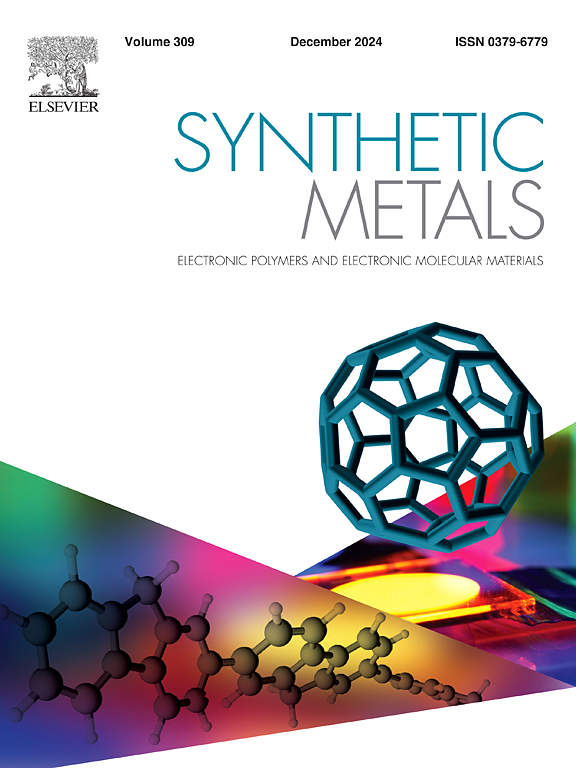电致变色用电聚合吡啶衍生物和线性吡啶盐
IF 4.6
3区 材料科学
Q2 MATERIALS SCIENCE, MULTIDISCIPLINARY
引用次数: 0
摘要
合成了以三苯胺(TPA)基为官能团的苯并噻唑(BTZ) (A)和苯并硒二唑(BSeZ) (B)为核心的两种新型线性吡啶衍生物及其相应的1和2己基链吡啶盐,并用光谱、电化学和光谱电化学方法对其进行了表征。吡啶衍生物A和B成功地电聚合到ITO电极上,得到了具有多色开关、良好的光学对比度和电致变色稳定性的聚合物薄膜(poly-A和poly-B)。聚a和聚b表现出三种可逆的颜色变化(米色↔橙色↔绿灰色),并定义了它们的电致变色稳定性、响应时间和光学对比度。相反,吡啶盐表现出更多的氧化还原过程,表现出多电致变色特性,具有多达五种不同且可逆的颜色变化(黄色↔紫色或微粉色↔橙色↔灰色),对应于发生适当的氧化还原形式。本文介绍了吡啶盐具有多重电致变色的例子。聚合物吡啶衍生物和吡啶盐作为电致变色活性材料具有良好的光学性能。本文章由计算机程序翻译,如有差异,请以英文原文为准。
Electropolymerized pyridine derivatives and linear pyridinium salts for electrochromic applications
Two novel linear pyridine derivatives containing benzothiadiazole (BTZ) (A) and benzoselenadiazole (BSeZ) (B) cores functionalized by triphenylamine (TPA) group, and their corresponding pyridinium salts with hexyl chains 1 and 2, were synthesized and characterized by spectroscopic, electrochemical, and spectroelectrochemical methods. The pyridine derivatives A and B were successfully electropolymerized onto the ITO electrode, obtaining as a result thin polymer films (poly-A and poly-B) with promising optical properties, including multicolor switching, good optical contrast and electrochromic stability. Poly-A and poly-B exhibited three reversible color changes (beige ↔ orange ↔ green-grey) and their electrochromic stability, response times and optical contrasts were defined. In contrast, the pyridinium salts exhibited a higher number of redox processes, showing multielectrochromic properties with up to five distinct and reversible color changes (yellow ↔ purple or slightly pink ↔ colorless ↔ orange ↔ grey), corresponding to occurring suitable redox forms. This study presents the example of pyridinium salts exhibiting multielectrochromism. Both polymeric pyridine derivatives and pyridinium salts indicate promising optical properties for using them as the active materials in electrochromic applications.
求助全文
通过发布文献求助,成功后即可免费获取论文全文。
去求助
来源期刊

Synthetic Metals
工程技术-材料科学:综合
CiteScore
8.30
自引率
4.50%
发文量
189
审稿时长
33 days
期刊介绍:
This journal is an international medium for the rapid publication of original research papers, short communications and subject reviews dealing with research on and applications of electronic polymers and electronic molecular materials including novel carbon architectures. These functional materials have the properties of metals, semiconductors or magnets and are distinguishable from elemental and alloy/binary metals, semiconductors and magnets.
 求助内容:
求助内容: 应助结果提醒方式:
应助结果提醒方式:


